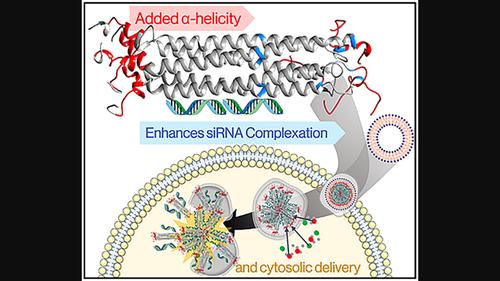当前位置:
X-MOL 学术
›
J. Pept. Sci.
›
论文详情
Our official English website, www.x-mol.net, welcomes your feedback! (Note: you will need to create a separate account there.)
Supercharged coiled‐coil protein with N‐terminal decahistidine tag boosts siRNA complexation and delivery efficiency of a lipoproteoplex
Journal of Peptide Science ( IF 2.1 ) Pub Date : 2024-03-19 , DOI: 10.1002/psc.3594 Jonathan W. Sun 1, 2 , Joseph S. Thomas 2, 3 , Julia M. Monkovic 2 , Halle Gibson 2 , Akash Nagapurkar 2 , Joseph A. Frezzo 2 , Priya Katyal 2 , Kamia Punia 2 , Farbod Mahoudinobar 2, 4 , P. Douglas Renfrew 4 , Jin Kim Montclare 1, 2, 5, 6
Journal of Peptide Science ( IF 2.1 ) Pub Date : 2024-03-19 , DOI: 10.1002/psc.3594 Jonathan W. Sun 1, 2 , Joseph S. Thomas 2, 3 , Julia M. Monkovic 2 , Halle Gibson 2 , Akash Nagapurkar 2 , Joseph A. Frezzo 2 , Priya Katyal 2 , Kamia Punia 2 , Farbod Mahoudinobar 2, 4 , P. Douglas Renfrew 4 , Jin Kim Montclare 1, 2, 5, 6
Affiliation

|
Short interfering RNA (siRNA) therapeutics have soared in popularity due to their highly selective and potent targeting of faulty genes, providing a non‐palliative approach to address diseases. Despite their potential, effective transfection of siRNA into cells requires the assistance of an accompanying vector. Vectors constructed from non‐viral materials, while offering safer and non‐cytotoxic profiles, often grapple with lackluster loading and delivery efficiencies, necessitating substantial milligram quantities of expensive siRNA to confer the desired downstream effects. We detail the recombinant synthesis of a diverse series of coiled‐coil supercharged protein (CSP) biomaterials systematically designed to investigate the impact of two arginine point mutations (Q39R and N61R) and decahistidine tags on liposomal siRNA delivery. The most efficacious variant, N8, exhibits a twofold increase in its affinity to siRNA and achieves a twofold enhancement in transfection activity with minimal cytotoxicity in vitro. Subsequent analysis unveils the destabilizing effect of the Q39R and N61R supercharging mutations and the incorporation of C‐terminal decahistidine tags on α‐helical secondary structure. Cross‐correlational regression analyses reveal that the amount of helical character in these mutants is key in N8's enhanced siRNA complexation and downstream delivery efficiency.
中文翻译:

带有 N 端十组氨酸标签的增压卷曲螺旋蛋白可提高 siRNA 复合和脂蛋白复合物的递送效率
短干扰 RNA (siRNA) 疗法因其对缺陷基因的高度选择性和有效靶向性而广受欢迎,为解决疾病提供了一种非姑息性方法。尽管它们具有潜力,但将 siRNA 有效转染到细胞中需要伴随载体的帮助。由非病毒材料构建的载体虽然提供了更安全且无细胞毒性的特性,但通常会遇到加载和递送效率低下的问题,需要大量昂贵的 siRNA 才能实现所需的下游效应。我们详细介绍了一系列不同系列的卷曲螺旋增压蛋白 (CSP) 生物材料的重组合成,这些生物材料经过系统设计,旨在研究两个精氨酸点突变(Q39R 和 N61R)和十组氨酸标签对脂质体 siRNA 递送的影响。最有效的变体 N8 对 siRNA 的亲和力增加了一倍,并在体外以最小的细胞毒性实现了转染活性的两倍增强。随后的分析揭示了 Q39R 和 N61R 增压突变以及 C 端十组氨酸标签在 α 螺旋二级结构上掺入的不稳定效应。互相关回归分析表明,这些突变体中螺旋特征的数量是 N8 增强 siRNA 复合和下游递送效率的关键。
更新日期:2024-03-19
中文翻译:

带有 N 端十组氨酸标签的增压卷曲螺旋蛋白可提高 siRNA 复合和脂蛋白复合物的递送效率
短干扰 RNA (siRNA) 疗法因其对缺陷基因的高度选择性和有效靶向性而广受欢迎,为解决疾病提供了一种非姑息性方法。尽管它们具有潜力,但将 siRNA 有效转染到细胞中需要伴随载体的帮助。由非病毒材料构建的载体虽然提供了更安全且无细胞毒性的特性,但通常会遇到加载和递送效率低下的问题,需要大量昂贵的 siRNA 才能实现所需的下游效应。我们详细介绍了一系列不同系列的卷曲螺旋增压蛋白 (CSP) 生物材料的重组合成,这些生物材料经过系统设计,旨在研究两个精氨酸点突变(Q39R 和 N61R)和十组氨酸标签对脂质体 siRNA 递送的影响。最有效的变体 N8 对 siRNA 的亲和力增加了一倍,并在体外以最小的细胞毒性实现了转染活性的两倍增强。随后的分析揭示了 Q39R 和 N61R 增压突变以及 C 端十组氨酸标签在 α 螺旋二级结构上掺入的不稳定效应。互相关回归分析表明,这些突变体中螺旋特征的数量是 N8 增强 siRNA 复合和下游递送效率的关键。



























 京公网安备 11010802027423号
京公网安备 11010802027423号